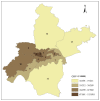Distribution of COVID-19 Morbidity Rate in Association with Social and Economic Factors in Wuhan, China: Implications for Urban Development
- PMID: 32422948
- PMCID: PMC7277377
- DOI: 10.3390/ijerph17103417
Distribution of COVID-19 Morbidity Rate in Association with Social and Economic Factors in Wuhan, China: Implications for Urban Development
Abstract
Social and economic factors relate to the prevention and control of infectious diseases. The purpose of this paper was to assess the distribution of COVID-19 morbidity rate in association with social and economic factors and discuss the implications for urban development that help to control infectious diseases. This study was a cross-sectional study. In this study, social and economic factors were classified into three dimensions: built environment, economic activities, and public service status. The method applied in this study was the spatial regression analysis. In the 13 districts in Wuhan, the spatial regression analysis was applied. The results showed that: 1) increasing population density, construction land area proportion, value-added of tertiary industry per unit of land area, total retail sales of consumer goods per unit of land area, public green space density, aged population density were associated with an increased COVID-19 morbidity rate due to the positive characteristics of estimated coefficients of these variables. 2) increasing average building scale, GDP per unit of land area, and hospital density were associated with a decreased COVID-19 morbidity rate due to the negative characteristics of estimated coefficients of these variables. It was concluded that it is possible to control infectious diseases, such as COVID-19, by adjusting social and economic factors. We should guide urban development to improve human health.
Keywords: COVID-19; Wuhan city; morbidity rate; social and economic factors; spatial regression analysis.
Conflict of interest statement
The authors declare no conflict of interest.
Figures





Similar articles
-
Associating COVID-19 Severity with Urban Factors: A Case Study of Wuhan.Int J Environ Res Public Health. 2020 Sep 15;17(18):6712. doi: 10.3390/ijerph17186712. Int J Environ Res Public Health. 2020. PMID: 32942626 Free PMC article.
-
Spatial Statistics and Influencing Factors of the COVID-19 Epidemic at Both Prefecture and County Levels in Hubei Province, China.Int J Environ Res Public Health. 2020 May 31;17(11):3903. doi: 10.3390/ijerph17113903. Int J Environ Res Public Health. 2020. PMID: 32486403 Free PMC article.
-
Associations Between Built Environment, Neighborhood Socioeconomic Status, and SARS-CoV-2 Infection Among Pregnant Women in New York City.JAMA. 2020 Jul 28;324(4):390-392. doi: 10.1001/jama.2020.11370. JAMA. 2020. PMID: 32556085 Free PMC article.
-
[Etiology of epidemic outbreaks COVID-19 on Wuhan, Hubei province, Chinese People Republic associated with 2019-nCoV (Nidovirales, Coronaviridae, Coronavirinae, Betacoronavirus, Subgenus Sarbecovirus): lessons of SARS-CoV outbreak.].Vopr Virusol. 2020;65(1):6-15. doi: 10.36233/0507-4088-2020-65-1-6-15. Vopr Virusol. 2020. PMID: 32496715 Review. Russian.
-
The Novel Coronavirus: A Bird's Eye View.Int J Occup Environ Med. 2020 Apr;11(2):65-71. doi: 10.15171/ijoem.2020.1921. Epub 2020 Feb 5. Int J Occup Environ Med. 2020. PMID: 32020915 Free PMC article. Review.
Cited by
-
Differential impact of mitigation policies and socioeconomic status on COVID-19 prevalence and social distancing in the United States.BMC Public Health. 2021 Jun 14;21(1):1140. doi: 10.1186/s12889-021-11149-1. BMC Public Health. 2021. PMID: 34126964 Free PMC article.
-
Are high-density districts more vulnerable to the COVID-19 pandemic?Sustain Cities Soc. 2021 Jul;70:102911. doi: 10.1016/j.scs.2021.102911. Epub 2021 Apr 3. Sustain Cities Soc. 2021. PMID: 36567891 Free PMC article.
-
Spatio-temporal patterns of the COVID-19 pandemic, and place-based influential factors at the neighborhood scale in Tehran.Sustain Cities Soc. 2021 Sep;72:103034. doi: 10.1016/j.scs.2021.103034. Epub 2021 May 21. Sustain Cities Soc. 2021. PMID: 36570724 Free PMC article.
-
Investigating the spatiotemporal characteristics and medical response during the initial COVID-19 epidemic in six Chinese cities.Sci Rep. 2024 Mar 25;14(1):7065. doi: 10.1038/s41598-024-56077-3. Sci Rep. 2024. PMID: 38528001 Free PMC article.
-
Epidemiological geography at work: An exploratory review about the overall findings of spatial analysis applied to the study of CoViD-19 propagation along the first pandemic year.GeoJournal. 2023;88(1):1103-1125. doi: 10.1007/s10708-022-10601-y. Epub 2022 Mar 29. GeoJournal. 2023. PMID: 35370348 Free PMC article. Review.
References
-
- Wobeser G. Towards the Endgame and Beyond: Complexities and Challenges for the Elimination of Infectious Diseases. J. Wildl. Dis. 2014;50:426. doi: 10.7589/50-2-BR2. - DOI
MeSH terms
Grants and funding
LinkOut - more resources
Full Text Sources

